Ali Baba | Case Study - MGMT3001
38 Pages8961 Words100 Views
Macquarie University
Added on 2020-03-04
About This Document
MGMT3001 - The case report shall briefly outline the case of Alibaba and strategies followed by them. It shall also conduct a SWOT analysis and Porter’s five forces analysis for Alibaba which would indicate us the benefits of altering strategies that Alibaba got. The report shall also discuss some of the measures Alibaba could take up at present to arrest the imminent issue of counterfeit goods. For being able to present the facts and figures to support the views, lots of reports, financial findings report etc. were referred.
Ali Baba | Case Study - MGMT3001
Macquarie University
Added on 2020-03-04
ShareRelated Documents
Ali Baba Case Study

Executive Summary
Alibaba Group was established in 1999 by 18 people headed by Jack Ma. Their only belief
was the power of internet which would help them level the small-time businesses with
assistance of technology and innovation to grow and eventually have a competitive edge in
national and global economy in future. It is China’s and in some measures also world’s
largest dot com company. It’s first venture being Alibaba.com – a simple platform to connect
buyers with China’s small and medium scale manufacturers. It had just 24 items for sale then.
Today, this Chinese e-commerce giant has its hands in C2C, B2C, B2B sales, electronic
payment systems, shopping portals, luxury products site, cloud computing services, online
money transfers, digital media wing (Shih and Qi, 2016), entertainment group etc. Jack Ma
belonged to Chinese city of Hangzhou where he started his career early-first as a tour guide
and then as an English teacher. He wanted to make it big and dissatisfied with the salary, he
started his own translation business after some trips of US, where he learnt about computers,
internet etc. he created the Chinese Yellow Pages and eventually in his tiny apartment started
Alibaba. It is an amazing history of fast paced growth and quickly Alibaba branched out to
various other companies all under umbrella of Alibaba Group. Today, Alibaba has Tmall,
Taobao, AliExpress, Alipay etc. Alibaba, through various mergers and strategic deals has
been dominating the Chinese ecommerce industry. It has always been visionary in its
approach and has been successful in converting the organization into a sustainable ecosystem
in itself.
2
Alibaba Group was established in 1999 by 18 people headed by Jack Ma. Their only belief
was the power of internet which would help them level the small-time businesses with
assistance of technology and innovation to grow and eventually have a competitive edge in
national and global economy in future. It is China’s and in some measures also world’s
largest dot com company. It’s first venture being Alibaba.com – a simple platform to connect
buyers with China’s small and medium scale manufacturers. It had just 24 items for sale then.
Today, this Chinese e-commerce giant has its hands in C2C, B2C, B2B sales, electronic
payment systems, shopping portals, luxury products site, cloud computing services, online
money transfers, digital media wing (Shih and Qi, 2016), entertainment group etc. Jack Ma
belonged to Chinese city of Hangzhou where he started his career early-first as a tour guide
and then as an English teacher. He wanted to make it big and dissatisfied with the salary, he
started his own translation business after some trips of US, where he learnt about computers,
internet etc. he created the Chinese Yellow Pages and eventually in his tiny apartment started
Alibaba. It is an amazing history of fast paced growth and quickly Alibaba branched out to
various other companies all under umbrella of Alibaba Group. Today, Alibaba has Tmall,
Taobao, AliExpress, Alipay etc. Alibaba, through various mergers and strategic deals has
been dominating the Chinese ecommerce industry. It has always been visionary in its
approach and has been successful in converting the organization into a sustainable ecosystem
in itself.
2
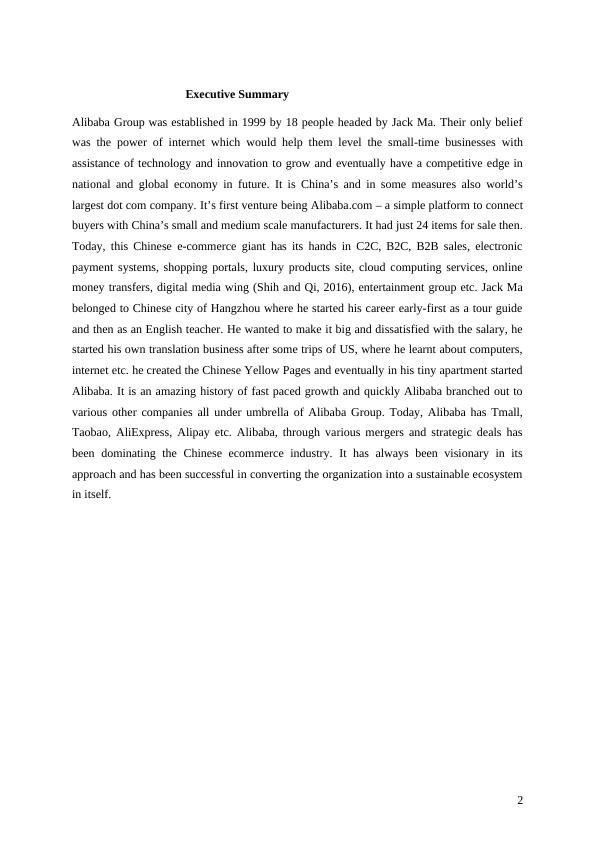
In September, 2014, Alibaba came up with largest ever Initial Public Offering. It raised
US$21.8 billion @$68 per share on New York Stock Exchange(NYSE). This is after it was
denied to list itself on Hong Kong Stock Exchange (HKEx) in 2013(Wei and Young, 2015).
This was on the grounds that HKEx did not agree to its request to exempt ‘one share one
vote’ policy (Chow, 2014). That would have allowed all 28 members – former or current
Alibaba managers to have a holding on the process of nominating board members (Burke and
Eaton, 2016).
Alibaba face a lot of adversity in its tenure, first there was threat posed by eBay after its entry
in Chinese market in 2002 just when things had started to look up for Alibaba. Then after
launch of Taobao in 2003, the credibility crisis cropped up after counterfeit goods (Chen,
2016) started surfacing. It plagues Alibaba’s business even today. Threat of new entrants kept
on coming, everybody vying for the lions chunk in new market. Today JD.com stands as the
fiercest competitor for Alibaba in China. Rounds of ‘going public’ and being denied
(Descovich et al., 2017) listing on HKEx owing to governance measures unacceptable by
HKEx made it difficult for Jack Ma, he had to wait for some time more and prepare itself for
entry and listing on NYSE which finally accepted them (Nwogogu, 2016).
3
US$21.8 billion @$68 per share on New York Stock Exchange(NYSE). This is after it was
denied to list itself on Hong Kong Stock Exchange (HKEx) in 2013(Wei and Young, 2015).
This was on the grounds that HKEx did not agree to its request to exempt ‘one share one
vote’ policy (Chow, 2014). That would have allowed all 28 members – former or current
Alibaba managers to have a holding on the process of nominating board members (Burke and
Eaton, 2016).
Alibaba face a lot of adversity in its tenure, first there was threat posed by eBay after its entry
in Chinese market in 2002 just when things had started to look up for Alibaba. Then after
launch of Taobao in 2003, the credibility crisis cropped up after counterfeit goods (Chen,
2016) started surfacing. It plagues Alibaba’s business even today. Threat of new entrants kept
on coming, everybody vying for the lions chunk in new market. Today JD.com stands as the
fiercest competitor for Alibaba in China. Rounds of ‘going public’ and being denied
(Descovich et al., 2017) listing on HKEx owing to governance measures unacceptable by
HKEx made it difficult for Jack Ma, he had to wait for some time more and prepare itself for
entry and listing on NYSE which finally accepted them (Nwogogu, 2016).
3
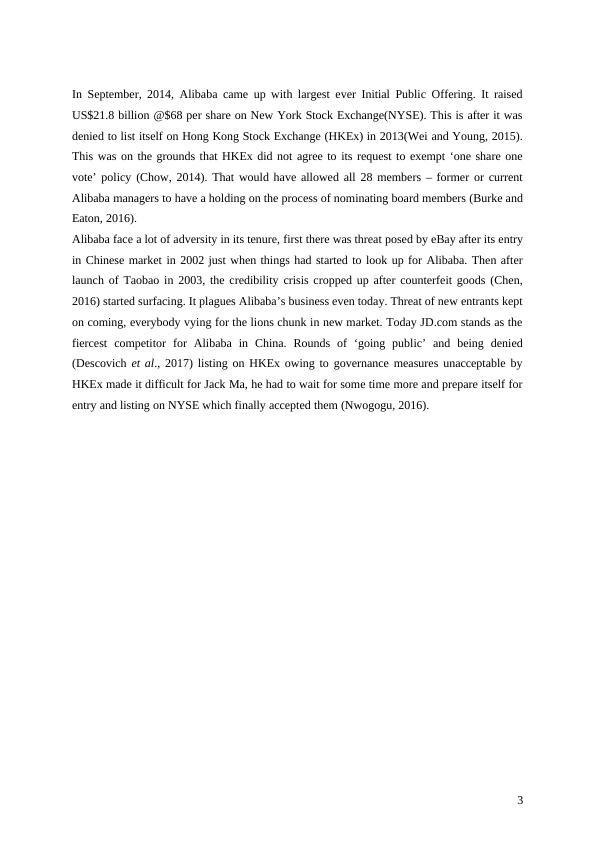
The case report shall briefly outline the case of Alibaba and strategies followed by them. The
report shall try to shed light on the governance issues in Alibaba (Lin, 2017). It shall also
conduct a SWOT analysis and Porter’s five forces analysis for Alibaba which would indicate
us the benefits of altering strategies that Alibaba got, how it eventually assisted Alibaba in its
international growth. The report shall also discuss some of the measures Alibaba could take
up at present to arrest the imminent issue of counterfeit goods (Hu and Guo, 2015). Last of
all, the report shall also discuss counterfeiting scenarios where Alibaba’s fake good problem
has been disturbing for ecommerce of China as a whole and what is ahead for them. For
being able to present the facts and figures to support the views, lots of reports, financial
findings report etc. were referred to which is also attached as appendices for perusal along
with a reference list.
4
report shall try to shed light on the governance issues in Alibaba (Lin, 2017). It shall also
conduct a SWOT analysis and Porter’s five forces analysis for Alibaba which would indicate
us the benefits of altering strategies that Alibaba got, how it eventually assisted Alibaba in its
international growth. The report shall also discuss some of the measures Alibaba could take
up at present to arrest the imminent issue of counterfeit goods (Hu and Guo, 2015). Last of
all, the report shall also discuss counterfeiting scenarios where Alibaba’s fake good problem
has been disturbing for ecommerce of China as a whole and what is ahead for them. For
being able to present the facts and figures to support the views, lots of reports, financial
findings report etc. were referred to which is also attached as appendices for perusal along
with a reference list.
4
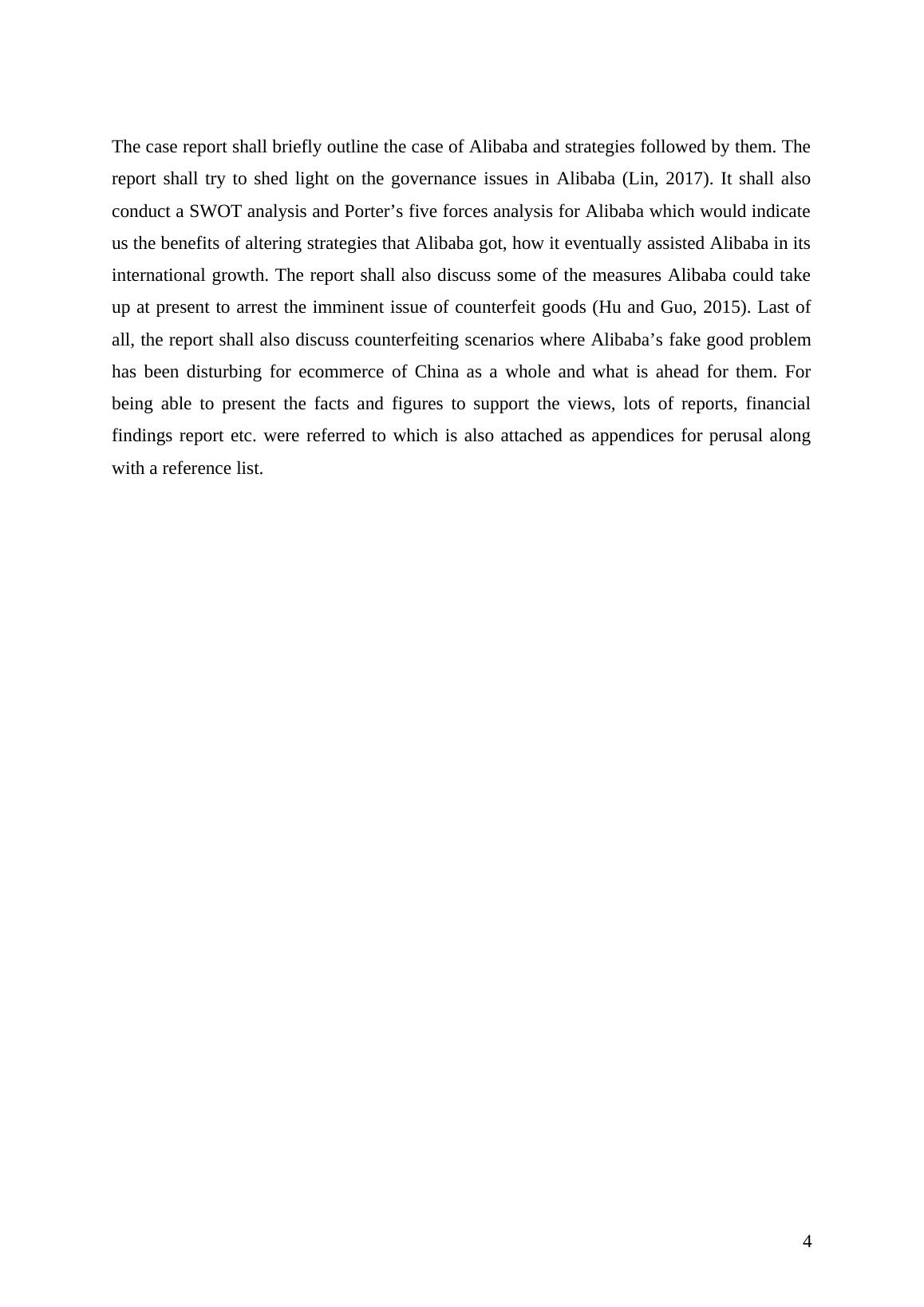

Chapter 1: Introduction
The case study ‘Alibaba goes public’ is a presentation of journey of Alibaba from its modest
beginnings to opening the largest IPO offering in US of about US$21.8 billion (Chen et al.,
2015). In the year 2014, Alibaba got its much-awaited debut on the New York Stock
Exchange, crafting not only the largest IPO in record but this original aspiration to list on the
Hong Kong Stock Exchange was refuted owing to the firm's request to reserve its colleague's
power over verdict privileges.
After working as an English tour guide and a teacher in city of Hangzhou, China, Jack Ma
realised his entrepreneurial dream of opening a venture of his own in year 1999 along with 17
others. He had a vision of a global e-commerce company that would survive a 102 year.
Alibaba was born. Ma trusted in his tactic to form a prosperous commerce in the Chinese
setting – universal image, native victory. Dissimilar to numerous other Chinese
businesspersons who modified effective U.S. internet business models that managed
Business-to-Consumer (B2C) and Consumer-to-Consumer (C2C) transactions, Alibaba
shaped its individual commercial prototype. It fixated on the Business-to-Business (B2B)
segment and linked small and medium sized firms with several others and opened it for the
world to communicate with these Chinese manufacturers.
6
The case study ‘Alibaba goes public’ is a presentation of journey of Alibaba from its modest
beginnings to opening the largest IPO offering in US of about US$21.8 billion (Chen et al.,
2015). In the year 2014, Alibaba got its much-awaited debut on the New York Stock
Exchange, crafting not only the largest IPO in record but this original aspiration to list on the
Hong Kong Stock Exchange was refuted owing to the firm's request to reserve its colleague's
power over verdict privileges.
After working as an English tour guide and a teacher in city of Hangzhou, China, Jack Ma
realised his entrepreneurial dream of opening a venture of his own in year 1999 along with 17
others. He had a vision of a global e-commerce company that would survive a 102 year.
Alibaba was born. Ma trusted in his tactic to form a prosperous commerce in the Chinese
setting – universal image, native victory. Dissimilar to numerous other Chinese
businesspersons who modified effective U.S. internet business models that managed
Business-to-Consumer (B2C) and Consumer-to-Consumer (C2C) transactions, Alibaba
shaped its individual commercial prototype. It fixated on the Business-to-Business (B2B)
segment and linked small and medium sized firms with several others and opened it for the
world to communicate with these Chinese manufacturers.
6
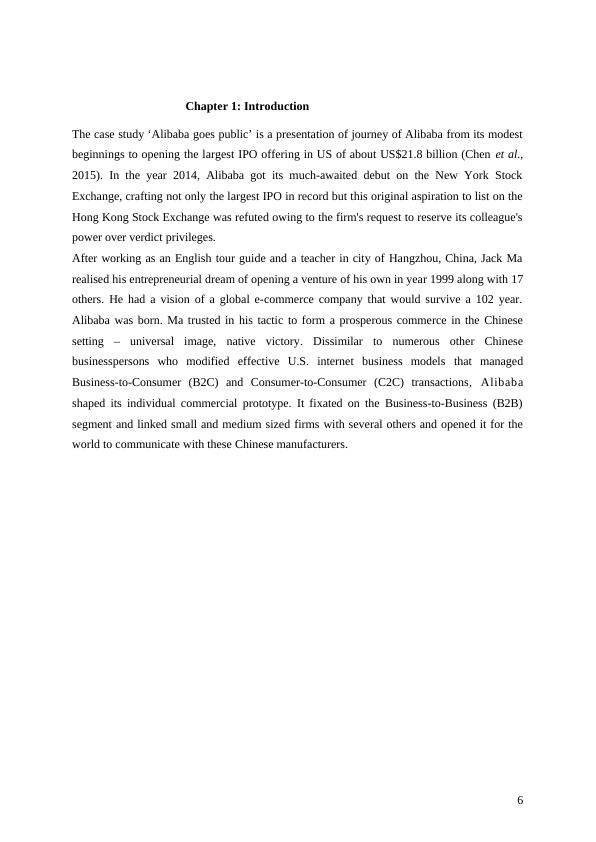
The Alibaba’s ethos is around supporting small businesses. They have created a functional
ecosystem where everyone who participates, such as, – customers, dealers, third-party facility
benefactors and others – have a break to flourish (Romagnoli and Garbelli, 2017). Alibaba’s
proclaimed six values of doing business are (Tsui et al., 2017):
Customer First - The welfares of society of consumers and vendors. This is their first priority.
Teamwork – This is where they acknowledge the employees who come next to customers.
Alibaba encourages a good team culture and believe that through proper teamwork, miracles
could happen.
Embrace Change – Alibaba acknowledges the fact that change is constant and one must be
flexible enough to adapt and quickly change the situation as a favourable one. Only the fittest
could survive.
Integrity - Alibaba appreciates integrity and encourages its employees to hold this at the core
of every transaction. They should strive to do the right thing and not take up unacceptable
measures.
Passion – Alibaba encourages all its members to keep doing work with a fire within and not
give up hope.
Commitment – Employees are always rewarded with recognition and other perks to keep up
their motivation level
Alibaba could be rightly explained as a combination of Amazon.com, eBay and PayPal with a
trace of Google tossed in, all with some distinctively Chinese personalities. Alibaba has
always worked as an intermediary, unlike Amazon. It simply connects buyers and sellers
while simplifying businesses among them. This is similar to character of eBay except that it
is not an auction organization.
7
ecosystem where everyone who participates, such as, – customers, dealers, third-party facility
benefactors and others – have a break to flourish (Romagnoli and Garbelli, 2017). Alibaba’s
proclaimed six values of doing business are (Tsui et al., 2017):
Customer First - The welfares of society of consumers and vendors. This is their first priority.
Teamwork – This is where they acknowledge the employees who come next to customers.
Alibaba encourages a good team culture and believe that through proper teamwork, miracles
could happen.
Embrace Change – Alibaba acknowledges the fact that change is constant and one must be
flexible enough to adapt and quickly change the situation as a favourable one. Only the fittest
could survive.
Integrity - Alibaba appreciates integrity and encourages its employees to hold this at the core
of every transaction. They should strive to do the right thing and not take up unacceptable
measures.
Passion – Alibaba encourages all its members to keep doing work with a fire within and not
give up hope.
Commitment – Employees are always rewarded with recognition and other perks to keep up
their motivation level
Alibaba could be rightly explained as a combination of Amazon.com, eBay and PayPal with a
trace of Google tossed in, all with some distinctively Chinese personalities. Alibaba has
always worked as an intermediary, unlike Amazon. It simply connects buyers and sellers
while simplifying businesses among them. This is similar to character of eBay except that it
is not an auction organization.
7

It competed with eBay to finally overthrow and compel it to exit from Chinese market by
introduction of Taobao (Valero, 2016). Unlike eBay, the only money that TaoBao took from
its sellers was for advertisements and merchant bidding for keywords for routing through
search results. It also introduced its own escrow service which was fee-free called Alipay to
arrest the trust issues between buyers and sellers. Soon, it became plagued with issues of
counterfeit goods and premium brands wanted to detach themselves from such a platform
(Ransom et al., 2014). That is how Tmall came into existence. Yue bao came into existence
on a need basis but eventually catapulted itself as a money parking station which provided
interest rates much more than Chinese banks. TaoBao’s mobile app became very successful
and accounted for 86% of sales in Chinese market through mobile app (Ma, 2016). Alibaba,
after getting its first funding and initial partnership with Yahoo in 2005, had made lots of
changes and has had ownership issues. In preparation of getting itself enlisted in HKEx, it
opted for internal strategies to evade denial of enlisting but all failed (Chan and Ho, 2014).
Finally, after much wait, it took its IPO to New York and Nasdaq. It met with much
objections with many governance experts outright criticising and showcasing pitfalls but
finally Alibaba did have what it sought (Petry, 2014). Their governance measures were
accepted by both Nasdaq and NYSE and the rest is history (Lin and Mehaffy, 2015).
8
introduction of Taobao (Valero, 2016). Unlike eBay, the only money that TaoBao took from
its sellers was for advertisements and merchant bidding for keywords for routing through
search results. It also introduced its own escrow service which was fee-free called Alipay to
arrest the trust issues between buyers and sellers. Soon, it became plagued with issues of
counterfeit goods and premium brands wanted to detach themselves from such a platform
(Ransom et al., 2014). That is how Tmall came into existence. Yue bao came into existence
on a need basis but eventually catapulted itself as a money parking station which provided
interest rates much more than Chinese banks. TaoBao’s mobile app became very successful
and accounted for 86% of sales in Chinese market through mobile app (Ma, 2016). Alibaba,
after getting its first funding and initial partnership with Yahoo in 2005, had made lots of
changes and has had ownership issues. In preparation of getting itself enlisted in HKEx, it
opted for internal strategies to evade denial of enlisting but all failed (Chan and Ho, 2014).
Finally, after much wait, it took its IPO to New York and Nasdaq. It met with much
objections with many governance experts outright criticising and showcasing pitfalls but
finally Alibaba did have what it sought (Petry, 2014). Their governance measures were
accepted by both Nasdaq and NYSE and the rest is history (Lin and Mehaffy, 2015).
8
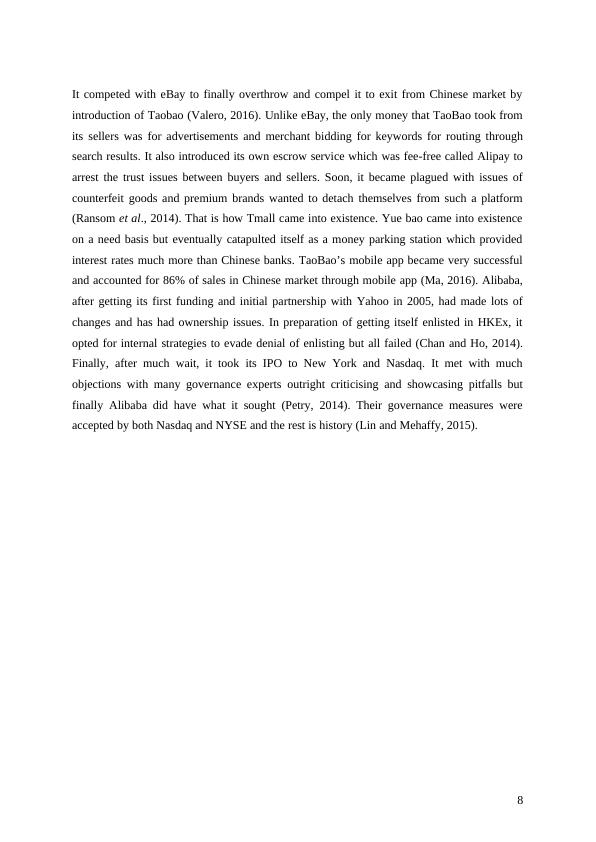
End of preview
Want to access all the pages? Upload your documents or become a member.
Related Documents
Alibaba's Jack Ma: Rise of the New Chinese Entrepreneurlg...
|11
|7044
|142
Alibaba business model Evaluation Assignment PDFlg...
|7
|1437
|181
Alibaba business model Evaluation Assignment PDFlg...
|7
|1422
|580
Entrepreneurship and Business Concept Analysis for Prime Restaurantlg...
|23
|4223
|437
IS 320 - Competitive Strategy Assignment | Alibaba and Tescolg...
|5
|1343
|54
Leadership & Management in Business & Managementlg...
|11
|2804
|300
